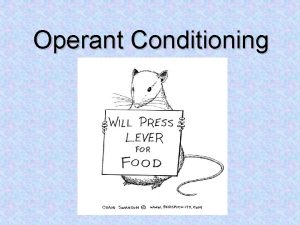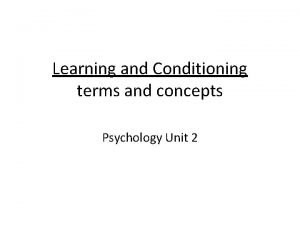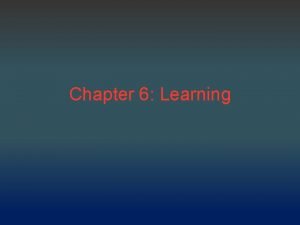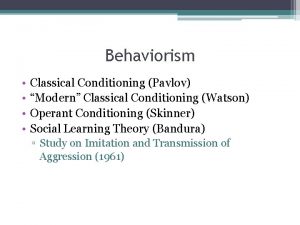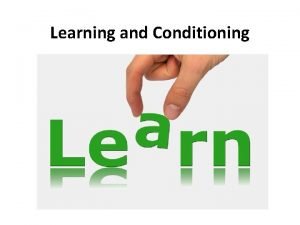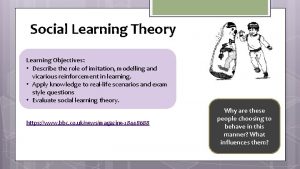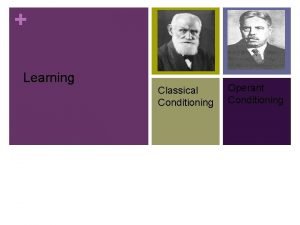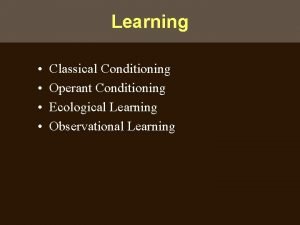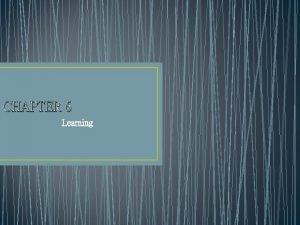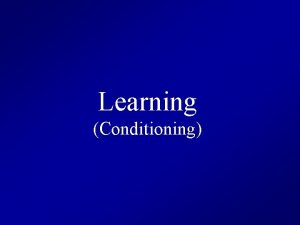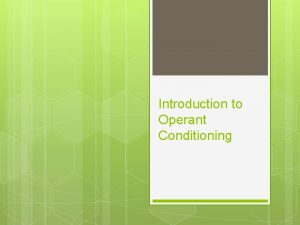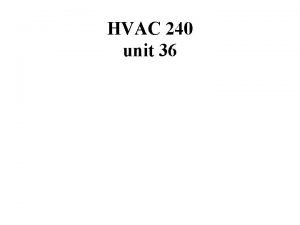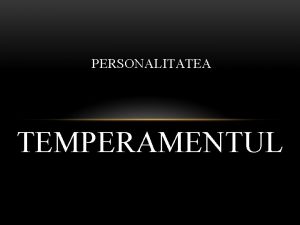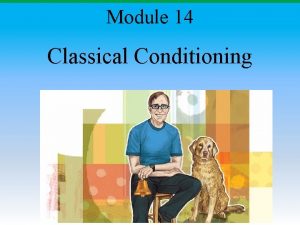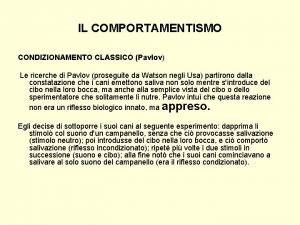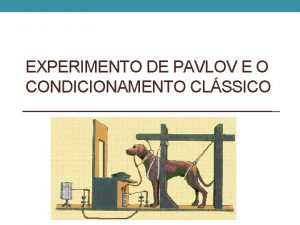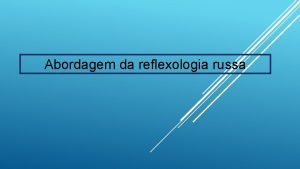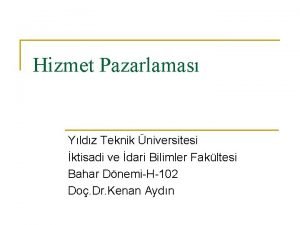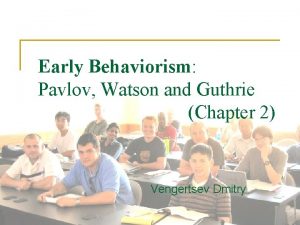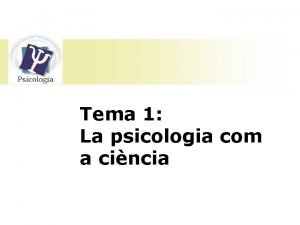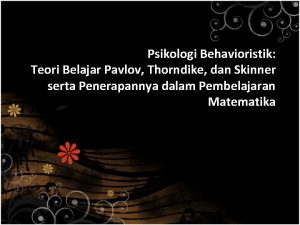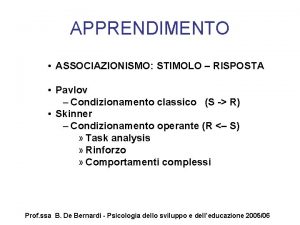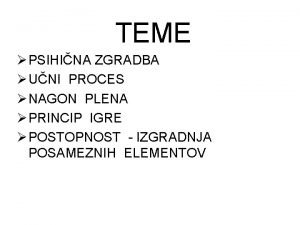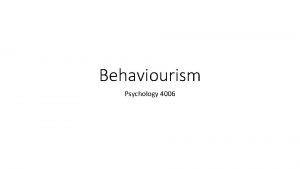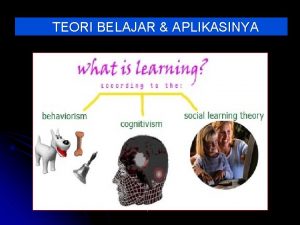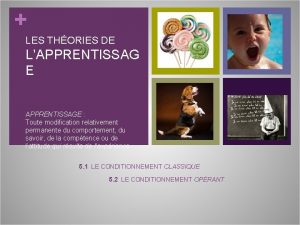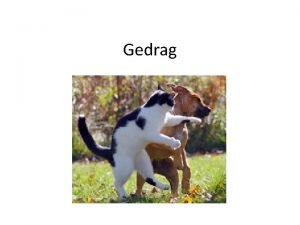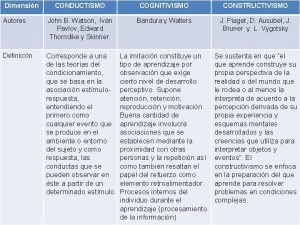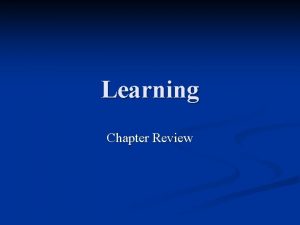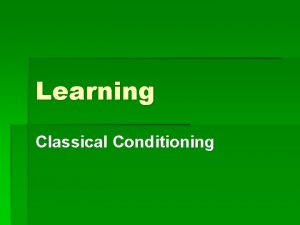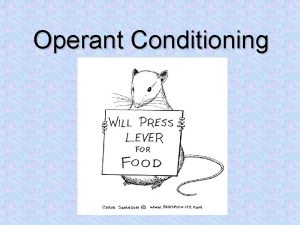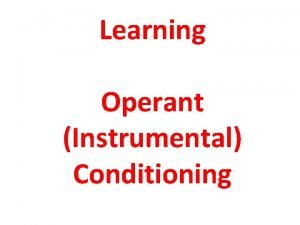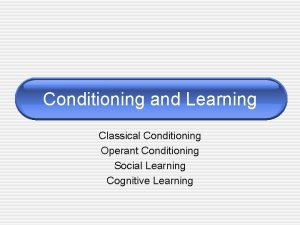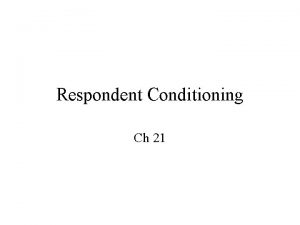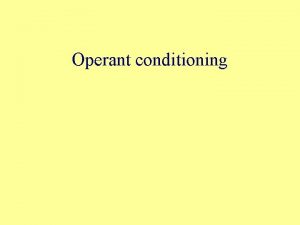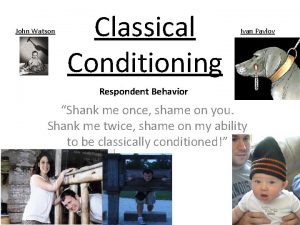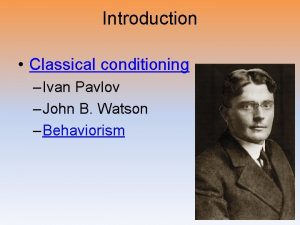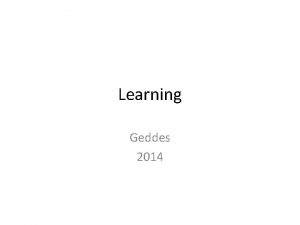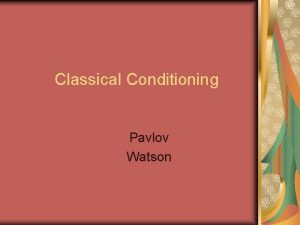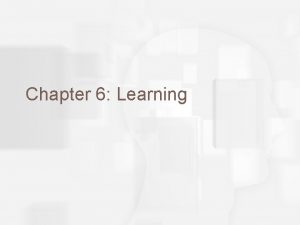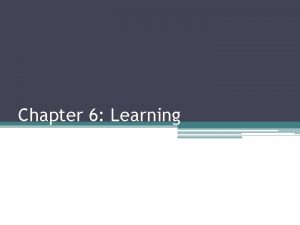UNIT 6 LEARNING I Pavlov CONDITIONING John Watso




























































- Slides: 60

UNIT 6: LEARNING I. Pavlov (CONDITIONING) John Watso n Classical Conditioning B. F. Skinner Operant Conditioning A. Bandu ra Observation al Learning

dog drool & bell Baby Albert pigeon reward & punishment Bo. Bo Doll learning by watching

UNIT 6 OVERVIEW � How � Do We Learn? objective 1 � Classical � objectives 2 -7 � Operant � Conditioning objectives 8 -13 � Learning � Conditioning by Observation objectives 14 -15 7 -9% of test TEST: Tuesday Nov. 25 th FRQ #3

Operant Conditioning OBJ. 8 -11 PGS. 228 -235 OBJ. 12 -13 PGS. 235 -240

OPERANT CONDITIONING

OBJECTIVE 8 WHAT IS OPERANT CONDITIONING & HOW IS IT DIFFERENT FROM CLASSICAL CONDITIONING �Respondent � behavior that occurs as an automatic response to some stimulus (no control) �Operant � behavior conditioning Associate own actions with consequences CLASSICAL CONDITIONING

SKINNER’S EXPERIMENTS � Edward Thorndike’s Law of Effect 1874 -1949 � Rewarded behavior is likely to recur � Puzzle box � � B. F. Skinner (1904 -1990) � behavior control � Teach pigeons unpigeonlike behavior

SKINNER’S EXPERIMENTS �Operant Chamber (Skinner Box)

SKINNER’S EXPERIMENTS SHAPING BEHAVIOR �Shaping �reinforcers guide successive approximations �Discriminative stimulus � in Which stimul type of us reactio gets the n th reinfo at is rced operant conditioning, a stimulus that elicits a response after association with reinforcement (in contrast to related stimuli not associated with reinforcement). � Teach pigeon to peck after seeing human face but not other images, pigeon learns to recognize faces…faces= discriminative stimulus

OBJECTIVE 9 WHAT ARE THE BASIC TYPES OF REINFORCERS? � Reinforcer � Anything that strengthens the behavior it follows � Positive 1. reinforcement – adds a positive Another term for reinforcement negative reinforcement: correction, a reprimand, � Negative – removes negative punishment � Not punishment 2. When you supply negative reinforcement it usually results in: weakening a behavior / strengthening a behavior � Removes a punishing event 3. Do people look forward to negative reinforcement: yes / no

NEGATIVE REINFORCEMENT � Taking aspirin to relieve headache � Putting mittens on because it is cold � Giving in to a whining child � Fanning oneself to escape the heat � Leaving a movie theater if the movie is bad � Smoking in order to relieve anxiety � Feigning stomachache to avoid school � Putting up umbrellas to escape the rain

SKINNER’S EXPERIMENTS TYPES OF REINFORCERS � � � Primary reinforcer � Satisfies a biological need Conditioned reinforcer � Gains its reinforcing power through its association w/ the primary reinforcer � Secondary Reinforcer Immediate vs Delayed Reinforcers � immediate best in animals � Humans respond to delayed � Social competent & highachieving

OBJECTIVE 10: WHAT ARE THE TWO REINFORCEMENT SCHEDULES & HOW DO THEY EFFECT BEHAVIOR? 1. Continuous Reinforcment � Learning occurs rapidly, but… � Extinction occurs rapidly 2. Partial (intermittent) Reinforcment � Slower to learn but more resistant to extinction � 4 types of partial schedules

Skinner’s Experiments Reinforcement Schedules � Ratio (2) � Interval (2) � involves a TIME element; dependent on the behavior time must pass before itself; a certain number of reinforcement will occur responses are needed before reinforcement will occur � FIXED –INTERVAL � FIXED –RATIO � reinforce 1 st response after � reinforce behavior after set # set time…produces stopof responses start behavior (more as reward draws near) � VARIABLE-RATIO � � high rate � VARIABLE-INTERVAL reinforce behavior after of slow/st � reinforce 1 st response afteread unpredictable # of respondin yrate o f varying time intervals responses…slot machine g re spondi n g

Skinner’s Experiments Reinforcement Schedules

Skinner’s Experiments Reinforcement Schedules

Skinner’s Experiments Reinforcement Schedules slot machine

Skinner’s Experiments Reinforcement Schedules

Reinforcement Schedules Interval: subject must b e behaving at th e right time to get reinforcement

OBJECTIVE 11: HOW DOES PUNISHMENT EFFECT BEAHVIOR? �Punishment �Positive punishment �Negative punishment Negative Reinforcement encourages behavior. When something unpleasant ceases, the behavior that caused it to stop is reinforced

Skinner’s Experiments Punishment

Skinner’s Experiments Punishment

Skinner’s Experiments Punishment

Skinner’s Experiments Punishment

Skinner’s Experiments Punishment

SENSITIVITY TO PUNISHMENT & REWARD QUESTIONNAIRE Are some of us more sensitive to punishment? Are some of us more sensitive to reward? Sensitivity to Punishment � Assign 1 point for each yes answer for odd #s � 0 -24 range Sensitivity to Reward � Assign 1 point for each yes answer for even #s High punish. Score vulnerable to anxiety. High reward score = impulsivity.

SKINNER’S EXPERIMENTS PUNISHMENT �Negatives �Punished of using punishment behavior is suppressed not forgotten �Punishment teaches discrimination � did child learn not to curse or just not to curse in house? �Punishment can teach fear �Physical punishment may increase aggression

Punishment tells you what not to do; reinforcement tells you what to do

OBJECTIVE 12: DO COGNITIVE PROCESSES & BIOLOGICAL CONSTRAINTS AFFECT OPERANT CONDITIONING? �Latent learning �Cognitive �Insight map learning � Intrinsic motivation � Extrinsic overjustification e ffect motivation

EXTENDING SKINNER’S UNDERSTANDING BIOLOGICAL PREDISPOSITIONS �Biological constraints predispose organisms to learn associations that are naturally adaptive �Instinctive Drift

SKINNER’S LEGACY APPLICATIONS OF OPERANT CONDITIONING �At school �In sports �At home �For self- improvement

CONTRASTING CLASSICAL AND OPERANT CONDITIONING �Similarities between classical and operant conditioning �Differences between classical and operant conditioning

Contrasting Classical and Operant Conditioning

Contrasting Classical and Operant Conditioning

Contrasting Classical and Operant Conditioning

Contrasting Classical and Operant Conditioning

Contrasting Classical and Operant Conditioning

Contrasting Classical and Operant Conditioning

Contrasting Classical and Operant Conditioning

Contrasting Classical and Operant Conditioning

Contrasting Classical and Operant Conditioning

Contrasting Classical and Operant Conditioning

Contrasting Classical and Operant Conditioning

Contrasting Classical and Operant Conditioning

Contrasting Classical and Operant Conditioning

Contrasting Classical and Operant Conditioning

Contrasting Classical and Operant Conditioning

Contrasting Classical and Operant Conditioning

Contrasting Classical and Operant Conditioning

Contrasting Classical and Operant Conditioning

Contrasting Classical and Operant Conditioning

Contrasting Classical and Operant Conditioning

Contrasting Classical and Operant Conditioning

Contrasting Classical and Operant Conditioning

Contrasting Classical and Operant Conditioning

Contrasting Classical and Operant Conditioning

Contrasting Classical and Operant Conditioning

Contrasting Classical and Operant Conditioning

Contrasting Classical and Operant Conditioning

Contrasting Classical and Operant Conditioning
 Pavlov types of conditioning
Pavlov types of conditioning Ivan pavlov classical conditioning
Ivan pavlov classical conditioning Pavlovs study
Pavlovs study Pavlov classical conditioning
Pavlov classical conditioning Pavlovian conditioning
Pavlovian conditioning Pavlov classical conditioning theory
Pavlov classical conditioning theory Difference between operant and classical conditioning
Difference between operant and classical conditioning Operant conditioning vs classical conditioning
Operant conditioning vs classical conditioning Classical and operant conditioning
Classical and operant conditioning Classical conditioning and operant conditioning.
Classical conditioning and operant conditioning. Operant conditoining
Operant conditoining Classical and operant conditioning
Classical and operant conditioning Classical vs operant conditioning
Classical vs operant conditioning Classical vs operant conditioning
Classical vs operant conditioning Classical conditioning vs operant conditioning
Classical conditioning vs operant conditioning Operant conditioning classical conditioning
Operant conditioning classical conditioning Educational implications of operant conditioning
Educational implications of operant conditioning Cuadro comparativo e-learning y b-learning
Cuadro comparativo e-learning y b-learning Assumptions of social learning theory
Assumptions of social learning theory Albert bandura operant conditioning
Albert bandura operant conditioning Types of reinforcement schedules
Types of reinforcement schedules Example of classical conditioning
Example of classical conditioning Instrumental learning vs classical conditioning
Instrumental learning vs classical conditioning Biological preparedness
Biological preparedness Example of fixed ratio schedule
Example of fixed ratio schedule Hydraulic fluid conditioning
Hydraulic fluid conditioning Close control unit
Close control unit Unit 36 refrigeration applied to air conditioning
Unit 36 refrigeration applied to air conditioning Unit 10, unit 10 review tests, unit 10 general test
Unit 10, unit 10 review tests, unit 10 general test Hristo pavlov
Hristo pavlov Skinner watson pavlov
Skinner watson pavlov Tipologia lui pavlov
Tipologia lui pavlov Pavlov reflexologia
Pavlov reflexologia Herzberg
Herzberg Classical conditioning little albert
Classical conditioning little albert Behaviorismo pavlov
Behaviorismo pavlov Experimento ivan pavlov
Experimento ivan pavlov Reflexologia ivan pavlov
Reflexologia ivan pavlov Pavlov'un şartlandırılmış öğrenme modeli
Pavlov'un şartlandırılmış öğrenme modeli Goran pavlov
Goran pavlov Pavlov'un şartlandırılmış öğrenme modeli
Pavlov'un şartlandırılmış öğrenme modeli Guthrie behaviorism
Guthrie behaviorism Ivan pavlovič pavlov
Ivan pavlovič pavlov Jenis teori belajar
Jenis teori belajar Skinner pavlov
Skinner pavlov Reflexologia pavlov
Reflexologia pavlov Eksperimen pavlov pada pembelajaran
Eksperimen pavlov pada pembelajaran Condicionamiento clasico de pavlov
Condicionamiento clasico de pavlov Reflexologia pavlov
Reflexologia pavlov Pavlov e o condicionamento clássico
Pavlov e o condicionamento clássico Pavlov
Pavlov Pavlov reflexologia
Pavlov reflexologia Pavlov reflexologia
Pavlov reflexologia Pavlovs dog
Pavlovs dog Manfaat teori belajar
Manfaat teori belajar Pavlov aprendizaje
Pavlov aprendizaje Publicité conditionnement classique
Publicité conditionnement classique Klasino
Klasino Klassieke conditionering
Klassieke conditionering Constructivismo cognitivismo y conductismo
Constructivismo cognitivismo y conductismo Ivan pavlov is most closely associated with
Ivan pavlov is most closely associated with
